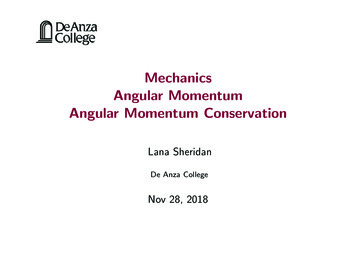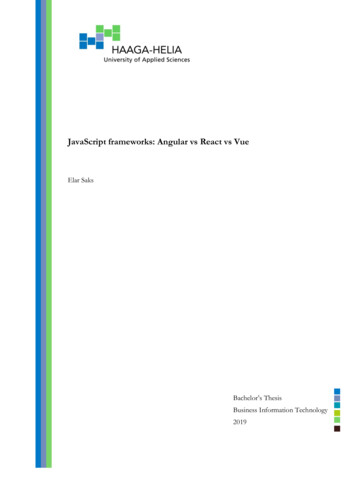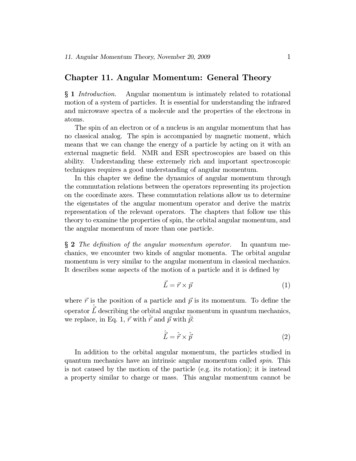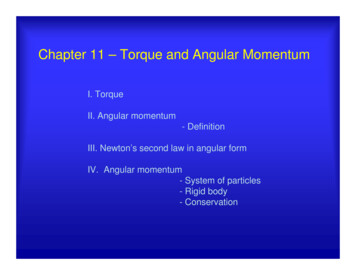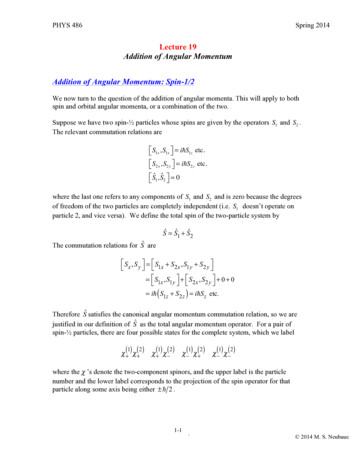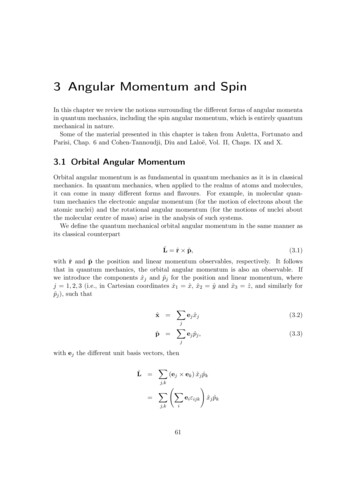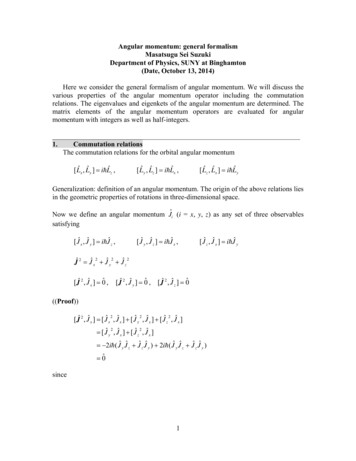
Transcription
Angular momentum: general formalismMasatsugu Sei SuzukiDepartment of Physics, SUNY at Binghamton(Date, October 13, 2014)Here we consider the general formalism of angular momentum. We will discuss thevarious properties of the angular momentum operator including the commutationrelations. The eigenvalues and eigenkets of the angular momentum are determined. Thematrix elements of the angular momentum operators are evaluated for angularmomentum with integers as well as half-integers.1.Commutation relationsThe commutation relations for the orbital angular momentum[ Lˆ x , Lˆ y ] i Lˆ z ,[ Lˆ y , Lˆ z ] i Lˆ x ,[ Lˆ z , Lˆ x ] i Lˆ yGeneralization: definition of an angular momentum. The origin of the above relations liesin the geometric properties of rotations in three-dimensional space.Now we define an angular momentum Jˆi (i x, y, z) as any set of three observablessatisfying[ Jˆ x , Jˆ y ] i Jˆ z ,[ Jˆ y , Jˆ z ] i Jˆ x ,[ Jˆ z , Jˆ x ] i Jˆ y222Jˆ 2 Jˆ x Jˆ y Jˆ z[ Jˆ 2 , Jˆ x ] 0̂ ,[ Jˆ 2 , Jˆ y ] 0̂ , [ Jˆ 2 , Jˆ z ] 0̂((Proof))222[ Jˆ 2 , Jˆ x ] [ Jˆ x , Jˆ x ] [ Jˆ y , Jˆ x ] [ Jˆ z , Jˆ x ]22 [ Jˆ y , Jˆ x ] [ Jˆ z , Jˆ x ] 2i ( Jˆ y Jˆ z Jˆ z Jˆ y ) 2i ( Jˆ y Jˆ z Jˆ z Jˆ y ) 0̂since1
2[ Jˆ y , Jˆ x ] Jˆ y Jˆ y Jˆ x Jˆ x Jˆ y Jˆ y Jˆ y ( Jˆ y Jˆ x Jˆ x Jˆ y ) ( Jˆ y Jˆ x Jˆ x Jˆ y ) Jˆ y Jˆ y [ Jˆ x , Jˆ y ] [ Jˆ x , Jˆ y ]Jˆ y 2i ( Jˆ y Jˆ z Jˆ z Jˆ y )2[ Jˆ z , Jˆ x ] Jˆ z Jˆ z Jˆ x Jˆ x Jˆ z Jˆ z Jˆ z ( Jˆ z Jˆ x Jˆ x Jˆ z ) ( Jˆ z Jˆ x Jˆ x Jˆ z ) Jˆ z Jˆ [ Jˆ , Jˆ ] [ Jˆ , Jˆ ]Jˆzzxzxz 2i ( Jˆ y Jˆ z Jˆ z Jˆ y )2.General theory of angular momentum(a)Jˆ and Jˆ Jˆ Jˆx iJˆywhereJˆ Jˆ ,Jˆ Jˆ [ Jˆ z , Jˆ ] Jˆ ,[ Jˆ z , Jˆ ] Jˆ ,[ Jˆ 2 , Jˆ ] [ Jˆ 2 , Jˆ ] [ Jˆ 2 , Jˆ z ] 0̂2Jˆ Jˆ Jˆ 2 Jˆ z Jˆ z2Jˆ Jˆ Jˆ 2 Jˆ z Jˆ zThus we have12Jˆ 2 ( Jˆ Jˆ Jˆ Jˆ ) Jˆ z2Formula:[a Jˆ , b Jˆ ] i (a b) Jˆ((Proof))2[ Jˆ , Jˆ ] 2 Jˆ z
I [a Jˆ , b Jˆ ] aib j [ Jˆi , Jˆ j ]i, jSince[ Jˆi , Jˆ j ] i ijk JˆkthenI aib j i ijk Jˆk i (a b) Jˆi, j(b)Notation for the eigenvalues of Ĵ 2 and JˆzFor any ket Jˆ 2 Jˆ x 2 Jˆ y 2 Jˆ z 2 Jˆ x Jˆ x Jˆ y Jˆ y Jˆ z Jˆ z 0For an eigenket Ĵ 2 Jˆ 2 0We shall writeJˆ 2 2 j ( j 1) 2 where j(j 1) 0((Note))Levi-Civita symbolIn three dimensions, the Levi-Civita symbol ijk is defined as follows: ijk is 1 if (i, j, k) is an even permutation of (1,2,3). ijk is -1 if it is an odd permutation, ijk is 0 if any index is repeated. 123 1 , 132 1 , 213 1 ,3
231 1 ,3. 312 1 , 321 1 .Eigenvalue equations for Jˆ2 and Jˆz j, mj.m is the simultaneous eigenket of Ĵ 2 and Jˆz , since [ Jˆ 2 , Jˆ z ] 0̂Jˆ 2 j , m 2 j ( j 1) j , mJˆ z j , m m j , mWe discuss the eigenvalues of Ĵ 2 and JˆzLemma 1(Properties of eigenvalues of Ĵ 2 and Jˆz )j and m satisfy the inequality-j m j((Proof))j , m Jˆ Jˆ j , m 0 ,4
j , m Jˆ Jˆ j , m 0 .We find2j , m Jˆ Jˆ j , m j , m Jˆ 2 Jˆ z Jˆ z j , m 2 [ j ( j 1) m(m 1)] 0 ,and2j , m Jˆ Jˆ j , m j , m Jˆ 2 Jˆ z Jˆ z j , m 2 [ j ( j 1) m(m 1)] 0 .Then we have[ j ( j 1) m (m 1)] ( j m )( j m 1) 0 ,[ j ( j 1) m (m 1)] ( j m 1)( j m ) 0 .Then ( j 1) m j ,and j m j 1.If j m j , these two conditions are satisfied simultaneously.Lemma II(Properties of the ket vector of Jˆ j , m )(i) If m -j, Jˆ j , m 0̂(ii) If m -j, Jˆ j , m is a non-null eigenket of Ĵ 2 and Jˆz with the eigenvalues j(j 1) 2and (m -1) .[Proof of (i))]Sincej , m Jˆ Jˆ j , m 2 [( j m)( j m 1)] 0for m -j, we getJˆ j , m 0̂5
for m -j.Conversely, ifJˆ j , m 0̂then we havej , m Jˆ Jˆ j , m 2 [( j m)( j m 1)] 0Then we have j -m.[Proof of (ii)]Since[ Jˆ 2 , Jˆ ] 0̂[ Jˆ 2 , Jˆ ] j , m 0̂orJˆ 2 Jˆ j , m Jˆ Jˆ 2 j , m 2 j ( j 1) Jˆ j , mSo Jˆ j , m is an eigenket of Ĵ 2 with the eigenvalue 2 j( j 1) .Moreover,[ Jˆ z , Jˆ ] j , m Jˆ j , morJˆ z Jˆ j , m Jˆ Jˆ z j , m Jˆ j , m (m 1) Jˆ j , mSo Jˆ j, m is an eigenket of Jˆz with the eigenvalue ( m 1) .Lemma III(i)(Properties of the ket vector of Jˆ j , m )If m j,Jˆ j , m 0̂ .6
(ii)If m j, Jˆ j , m is a non-null eigenket of Ĵ 2 and Jˆz with the eigenvalues j(j 1) 2and (m 1) .[Proof of (i)]j, m Jˆ Jˆ j, m 2 [( j m)( j m 1)] 0If m j, thenJˆ j , m 0̂ .[Proof of (ii)][ Jˆ 2 , Jˆ ] 0̂ ,or[ Jˆ 2 , Jˆ ] j , m 0̂ ,orj , m Jˆ 2 Jˆ j , m 2 j ( j 1) Jˆ j , m .2Jˆ j, m is an eigenket of Jˆ with an eigenvalues 2j(j 1).[ Jˆ z , Jˆ ] j , m Jˆ j , morJˆ z Jˆ j , m Jˆ Jˆ z j , m Jˆ j , m (m 1) j , mJˆ j , m is an eigenket of Jˆz with an eigenvalues (m 1).4.Determination of the spectrum of Jˆ2 and Jˆz .There exists a positive or zero integer p such thatm - p -j(1)j , m : [eigenvalues m, 2j(j 1)]7
Jˆ j , m : [ (m-1), 2j(j 1)]( Jˆ ) 2 j , m : [ (m-2), 2j(j 1)].( Jˆ ) p j , m : [ (m-p), 2j(j 1)]( Jˆ ) p 1 j , m 0̂There exists a positive or zero integer such thatm q j,(2)j , m : [eigenvalues m, 2j(j 1)]Jˆ j , m : [ (m 1), 2j(j 1)]( Jˆ ) 2 j , m : [ (m 2), 2j(j 1)].( Jˆ ) q j , m : [ (m q), 2j(j 1)]( Jˆ ) q 1 j , m 0̂Combining Eqs.(1) and (2),p q 2jSince p and q are integers, j is therefore an integer or a half-integer.j 0, 1/2, 1, 3/2, 2, .m -j, -j 1,., j-1, j.(i)(ii)5.If j is an integer, then m is an integer.If j is a half-integer, then m is a half-integer.j, m representation8
2j , m Jˆ Jˆ j , m j , m Jˆ 2 Jˆ z Jˆ z j , m 2 [( j m)( j m 1)]SinceJˆ j , m j , m 1we have2j , m Jˆ Jˆ j , m 2 [( j m)( j m 1)] .ThusJˆ j , m ( j m)( j m 1) j , m 1 .Similarly2j , m Jˆ Jˆ j , m j , m Jˆ 2 Jˆ z Jˆ z j , m 2 [( j m)( j m 1)] .SinceJˆ j , m j , m 1 ,we havej , m Jˆ Jˆ j , m 2 [( j m)( j m 1)] ,2orJˆ j, m ( j m )( j m 1) j, m 1 .In summary:Jˆ 2 j , m 2 j ( j 1) j , mJˆ z j, m m j, mJˆ j, m ( j m )( j m 1) j, m 1Jˆ j, m ( j m)( j m 1) j, m 19
6.Matrix element of the angular momentumUsing Mathematica, you determine the matrix elements of Jˆx , Jˆy , and JˆzJˆ 2 j.m 2 j ( j 1) j.mJˆ z j , m m j , mJˆ j , m ( j m)( j m 1) j , m 1Jˆ j , m ( j m)( j m 1) j , m 1SinceJˆ Jˆ x iJˆ yJˆ Jˆ x iJˆ ywe get1Jˆ x ( Jˆ Jˆ )21iJˆ y ( Jˆ Jˆ ) ( Jˆ Jˆ )2i21Jˆ x j , m ( Jˆ Jˆ ) j , m2 ( ( j m)( j m 1) j , m 1 ( j m)( j m 1) j , m 1 )2iJˆ y j , m ( Jˆ Jˆ ) j , m2i ( ( j m)( j m 1) j , m 1 ( j m)( j m 1) j , m 1 )2Jˆ z j , m m j , mThus the matrix elements are expressed by10
j , m' Jˆ x j , m ( ( j m)( j m 1) j , m' j , m 1 ( j m)( j m 1) j , m' j , m 1 )2 ( ( j m)( j m 1) m ', m 1 ( j m)( j m 1) m ', m 1 )2i j , m' Jˆ y j , m ( ( j m)( j m 1) j , m' j , m 1 ( j m)( j m 1) j , m' j , m 1 )2i ( ( j m)( j m 1) m ',m 1 ( j m)( j m 1) m ',m 1 )2j.m' Jˆ z j , m m j , m j , m' m m ,m 'Using this formula, we can get the matrix of Ĵ x , Ĵ y , and Ĵ z for each j ( 1/2, 1, 3/2, 2,5/2, .) and m ( j, j-1, j-2,., -j 1, -j).7.Effect of fluctuation in the direction of JWe now consider the fluctuation of the angular momentum, J x 2 J 2y2j , m ( Jˆ x Jˆ x 1̂) 2 j , m Jˆ x Jˆ x2 j, m ( Jˆ y Jˆ y 1̂) 2 j, m Jˆ y Jˆ y22 Jˆ x22 Jˆ yThen we haveJˆ 2 2 j ( j 1)222 Jˆ x Jˆ y Jˆ z222 J x J x Jˆ z J x J x 2 m 222or J x 2 J x 2 2 [ j( j 1) m 2 ]The fluctuation in the component of the angular momentum which is normal to the z axiswill be a minimum when m j. We therefore obtain[ J x J x ]min j 22211
This means in a rough manner of speaking that the minimum angle between the directionof the J vector and the z axis is given bysin min jj ( j 1) 1j 1orcos min jj ( j 1)((D. Bohm, quantum theory, p.319))It is not correct to imagine that the angular momentum points in some definitedirection which we do not happen to be able to measure with complete precision. Instead,whenever Ĵ 2 and Ĵ z have definite values, one should imagine that the entire cone ofdirections corresponding to those values of Jx and Jy consistent with the given j2 and mare covered simultaneously because important physical consequence may follow from theeffects of interference of wave functions corresponding to different components ofangular momentum.8.Vector representation of allowed angular momentumWe consider a case which j is some fixed number (j 1/2, 1, 3/2, 1,.). Then the totalangular momentum may be represented by a vector of length j ( j 1)The component m in the z direction ism j, j - 1, j - 2, ., -j 1, -jThe vector J should be thought of as covering a cone, with vector angle given bycos m mj ( j 1)(a)j 1/2m 1/2, -1/212
1 2 1 2 1 m 1 2m -1 2(b)j 1m 1, 0, -113
1 1 1 m 1m 0m -1(c)j 3/2m 3/2, 1/2, -1/2, -3/214
3 2 3 2 1 m 3 2m 1 2m -1 2m -3 2(d)j 3m 3, 2, 1, 0, -1, -2, -315
3 3 1 m 3m 2m 1m 0m -1m -2m -3(e)j 6m 6, 5, 4, 3, 2, 1, 0, -1, -2, -3, -4, -5, -616
6 6 1 m 6m 5m 4m 3m 2m 1m 0m -1m -2m -3m -4m -5m -6(a)j integers17
(b) j half integer18
REFERENCESJ.J. Sakurai, Modern Quantum Mechanics, Revised Edition (Addison-Wesley, ReadingMassachusetts, 1994).C. Cohen-Tannoudji and B. Diu, and F. Laloe, Quantum Mechanics, vol.1 and vol. 2(John Wiley & Sons, New York, 1977).A.R. Edmonds, Angular Momentum in Quantum Mechanics (Princeton University Press,1957).19
M.E. Rose, Elementary Theory of Angular Momentum (John Wiley & Sons, 1957, NewYork, Dover Publications, New York, 1957).L.C. Biedenharn and J.D. Louck, Angular Momentum in Quantum Physics (AddisonWesley, Reading, 1981).D.M. Brink and G.R. Satchler, Angular Momentum, 2nd edition (Clarendon Press, Oxford,1968).D.H. McIntyre, Quantum Mechanics: A paradigms Approach (Pearson, 2012).V. Devanthan, Angular Momentum Techniques in Quantum Mechanics (KluwerAcademic).20
Here we consider the general formalism of angular momentum. We will discuss the various properties of the angular momentum operator including the commutation relations. The eigenvalues and eigenkets of the angular momentum are determined. The matrix elements of the angular momentum operators are evaluated for angular


